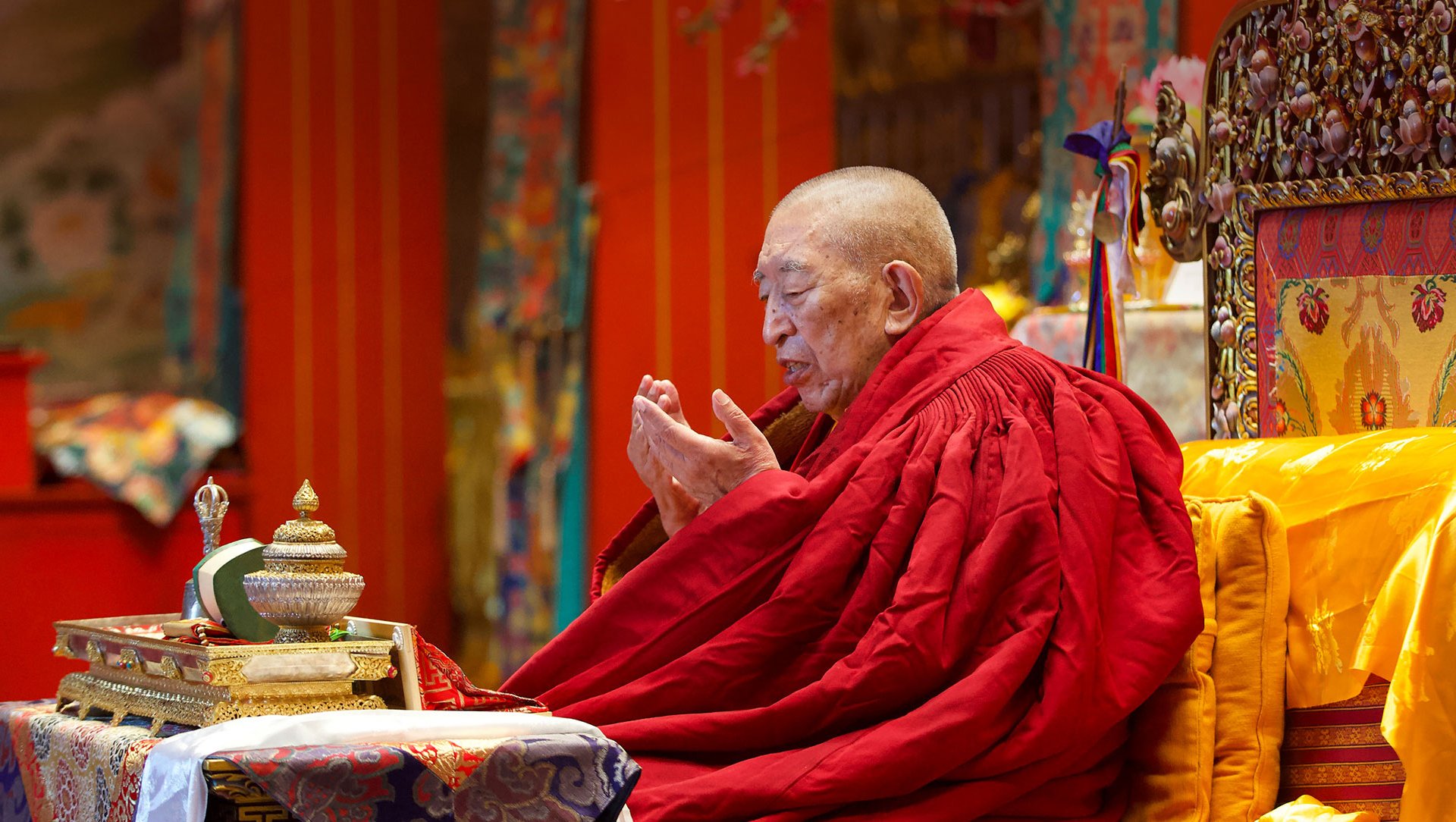
OUR KAGYU LINEAGE
about our root teacher, founder and the history of the karma kagyu lineage
Our Root Teacher Khenchen Thrangu Rinpoche (1933–2023)
Venerable Khenchen Thrangu Rinpoche, recognized by His Holiness the Sixteenth Karmapa and Tai Situpa as the ninth incarnation of the great Thrangu tulku.
Khenchen Thrangu Rinpoche was one of the foremost living masters of the Karma Kagyu lineage and the guiding teacher behind the Vajra Vidya network. He was widely loved for making profound teachings—especially Mahamudra—clear, practical, and warm-hearted.
Recognition & training: Born in Kham, Tibet, Rinpoche was recognized at age five as the ninth Thrangu tulku by the 16th Karmapa and Tai Situpa. He received full monastic training and, in exile, completed the Geshe Lharampa degree and the title Khenchen (“great abbot”).
Teacher of teachers: At Rumtek Monastery, the Karmapa’s seat in India, he rebuilt the monastic curriculum, served as Abbot of the Nalanda Institute, and trained many of the lineage’s younger tulkus. At the Dalai Lama’s request, he later served as a principal tutor to the 17th Gyalwang Karmapa.
Institutions & service: Rinpoche founded and guided monasteries, colleges, nunneries, and humanitarian projects—including Vajra Vidya Institute (Sarnath), Tara Abbey for nuns, and schools and clinics serving Himalayan communities.
Teaching in the West: From the mid-1970s he taught widely across Europe and North America and established centers in the United States and Canada.
Parinirvana: Rinpoche passed into parinirvana on June 4, 2023. His writings, recorded teachings, and the teachers he trained continue his work around the world.
“Study clearly, practice steadily, and keep a gentle heart.” — a guidance Rinpoche repeated often to students.
THE KARMA KAGYU LINEAGE
What “Kagyu” means
Kagyu (བཀའ་བརྒྱུད་) literally means “the oral lineage” or “the lineage of direct instruction.” It emphasizes personal transmission from teacher to student—study joined with meditation, retreat, and guidance. Within Kagyu there are several branches; Karma Kagyu is the largest and the home tradition of Vajra Vidya Retreat Center.
The Karma Kagyu line
The Karma Kagyu traces a continuous stream of practice from:
Tilopa (988–1069) → Naropa (1016–1100): the root instructions (including the Six Dharmas).
Marpa Lotsāwa (1012–1097): translator who brought these methods from India to Tibet.
Milarepa (1040–1123): exemplar of meditation and retreat.
Gampopa (1079–1153): united Kadam monastic training with Mahamudra and Vajrayāna practice, creating the Kagyu synthesis we follow today.
The Karmapas (starting 12th c.): a line of realized masters who hold the transmission for the Karma Kagyu school.
This stream is sometimes summarized as “learning, reflection, meditation; guided by a living teacher.”
A brief arc of the lineage
From Marpa to Milarepa to Gampopa in the 11th–12th centuries, through the line of the Karmapas, the Kagyu teachings were preserved through upheaval and brought into the modern era. In the 20th century the 16th Karmapa shepherded the lineage in exile; in the decades that followed, Thrangu Rinpoche rebuilt training for a new generation and opened doors for Western students. Today, Vajra Vidya centers—including Crestone—carry that stream forward through study, meditation, and retreat guided by resident teachers.
Vajra Vidya Retreat Center in this lineage
Vajra Vidya Retreat Center in Crestone, Colorado was founded within Thrangu Rinpoche’s vision to preserve the Kagyu teachings while making deep practice accessible in modern life. We follow a study–practice–retreat model that mirrors the Kagyu balance of learning and direct realization. Our Resident Teachers are Khenpo Lobzang, Khenpo Jigme and Ani Lodro Palmo. These teachers uphold the training methods and teaching style that Thrangu Rinpoche modeled: clarity, accuracy, and kindness.
Core practices we emphasize
Mahamudra: the heart of Kagyu meditation, taught gradually through calm-abiding, insight, and pointing-out instructions when appropriate.
Ngöndro (Foundational Practices): a structured path that prepares body, speech, and mind for deeper practice.
Daily liturgy & group practice: including Chenrezik (compassion), Green Tara, and protector practices, in harmony with the Vajra Vidya tradition.
Retreat: from weekend immersions to longer private retreats, with teacher guidance.
(Specific schedules and prerequisites are listed on our Retreats & Calendar page.)
How we honor the lineage at Vajra Vidya
Practice at Vajra Vidya follows a step-by-step Mahamudra path: calming the mind, cultivating insight, and, when appropriate, receiving pointing-out instructions. Students prepare through Ngöndro (foundational practices) that steady body, speech, and mind. Daily liturgy such as Chenrezik, Green Tara, and protector practices, keeps study anchored in living ritual, and regular retreat (from short immersions to longer private periods) provides the container for sustained meditation. Guidance flows through personal interviews and group teachings; the curriculum mirrors the Vajra Vidya / Nalanda model Thrangu Rinpoche established. In keeping with his example, practice naturally extends into generosity and service—care for community, teachers, and place.
Further study
For those who wish to go deeper, we recommend beginning with Thrangu Rinpoche’s introductory works on Mahamudra, then joining a beginner series or weekend retreat. Biographies of Marpa, Milarepa, Gampopa, and the Karmapas add helpful historical context, and recordings from Vajra Vidya centers offer a living voice for the teachings.




